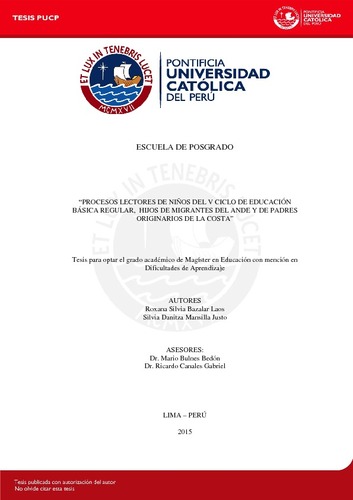| dc.contributor.advisor | Bulnes Bedón, Mario Santiago | |
| dc.contributor.advisor | Canales Gabriel, Ricardo | |
| dc.contributor.author | Bazalar Laos, Roxana Silvia | es_ES |
| dc.contributor.author | Mansilla Justo, Silvia Danitza | es_ES |
| dc.date.accessioned | 2015-07-17T17:37:09Z | |
| dc.date.available | 2015-07-17T17:37:09Z | |
| dc.date.created | 2015 | |
| dc.date.issued | 2015-07-17 | |
| dc.identifier.uri | http://hdl.handle.net/20.500.12404/6170 | |
| dc.description.abstract | El objetivo principal de esta investigación se centra en comparar el nivel
de los procesos lectores de niños que habitan en la zona de Huaycán, donde gran
parte de la población es de origen provinciano. Para esta comparación se
consideró el lugar de procedencia de los padres y de las madres, ya sean migrantes
del ande o procedentes de la costa.
El enfoque de la investigación es mixto, de tipo descriptivo comparativo.
Participaron 153 niños de 5to y 6to grado, de los cuales 38 son hijos de madre de
origen andino y 37 de madres originarias de la costa; respecto del lugar de
procedencia de los padres, 42 son provenientes del ande y 28 de la costa. Se
aplicó a los niños de la muestra el Test PROLEC-R y se analizaron los puntajes
obtenidos según cinco sub-clasificaciones formadas de acuerdo con el lugar de
procedencia de los padres.
Los resultados confirmaron la hipótesis general al haber hallado
diferencias significativas en cuatro de las cinco sub-clasificaciones analizadas. En
el análisis a nivel del índice de precisión lectora, los hijos de migrantes andinos
obtuvieron mejores resultados. Por el contrario, los hijos de padres costeños
obtuvieron resultados más favorables en velocidad lectora. | es_ES |
| dc.description.abstract | The main purpose of this research is to compare the level of the reading
processes of children living in the area of Huaycán, where much of the population
has come from provinces. For this comparison, we have considered the place of
birth of the parents, whether they have migrated from the Andes or they were born
in the Coast.
This is a mixed method research, with descriptive and comparative design.
153 children from 5th y 6th grade were examined, of which 38 have mothers of
Andean origin, and 37 have mothers born in the Coast; with regard to the fathers,
42 were born in the Andes and 28 are from the Coast. The children were evaluated
with the Test PROLEC-R and the scores were analyzed in relation to five
subclassifications made according to their parents’ place of origin.
The results confirmed the main hypothesis, having found significative
differences in four of the five subclassifications analyzed. When analyzing the
reading accuracy, the children of Andean migrants outperformed. On the other
hand, children of parents born in the Coast obtained better results in reading
speed. | es_ES |
| dc.language.iso | spa | es_ES |
| dc.publisher | Pontificia Universidad Católica del Perú | es_ES |
| dc.rights | Atribución 2.5 Perú | * |
| dc.rights | info:eu-repo/semantics/openAccess | es_ES |
| dc.rights.uri | http://creativecommons.org/licenses/by/2.5/pe/ | * |
| dc.subject | Lectura--Estudio y enseñanza (Primaria) | es_ES |
| dc.subject | Psicolingüística. | es_ES |
| dc.subject | Educación primaria--Perú--Investigaciones. | es_ES |
| dc.title | Procesos lectores de niños del V ciclo de educación básica regular, hijos de migrantes del ande y de padres originarios de la costa. | es_ES |
| dc.type | info:eu-repo/semantics/masterThesis | es_ES |
| thesis.degree.name | Magíster en Educación con mención en Dificultades de Aprendizaje | es_ES |
| thesis.degree.level | Maestría | es_ES |
| thesis.degree.grantor | Pontificia Universidad Católica del Perú. Escuela de Posgrado | es_ES |
| thesis.degree.discipline | Educación con mención en Dificultades de Aprendizaje | es_ES |
| renati.advisor.dni | 08258705 | |
| renati.discipline | 199437 | es_ES |
| renati.level | https://purl.org/pe-repo/renati/level#maestro | es_ES |
| renati.type | http://purl.org/pe-repo/renati/type#tesis | es_ES |
| dc.publisher.country | PE | es_ES |
| dc.subject.ocde | https://purl.org/pe-repo/ocde/ford#5.03.01 | es_ES |






